Intel Architecture Day 2021: Alder Lake, Golden Cove, and Gracemont Detailed
by Dr. Ian Cutress & Andrei Frumusanu on August 19, 2021 9:00 AM ESTGolden Cove Microarchitecture (P-Core) Examined
Section by Andrei Frumusanu
Within Alder Lake and Sapphire Rapids, we find Intel’s brand-new performance core (P-Core) microarchitecture, called Golden Cove. The new microarchitecture and core design follows the Willow Cove core in Tiger Lake, the Sunny Cove core in Ice Lake, and the derivative Cypress Cove core in Rocket Lake.
Although the new design is a follow-up over the last few years of core microarchitectures, Intel sees the Golden Gove as a major step-function update, with massive revamps of the fundamental building blocks of the CPU, going as far as calling it as allowing performance for the next decade of compute, meaning Intel is seemingly planning on using it as the basis for the evolution of cores for at least a few years.
The last time we had seen major upgrades to Intel’s core front-end was in Ice Lake's Sunny Cove, making notable increases in the microarchitecture’s out-of-order execution capabilities and depth, while Willow Cove and Cypress Cove were more iterative designs focusing on the memory subsystem.
Golden Cove, in comparison, makes gigantic changes to the microarchitecture’s front-end – in fact, Intel states that this is the largest microarchitectural upgrade in the core family in a decade, mirroring similar changes in magnitude to what Skylake had done many years ago.
Starting off with the directly most obvious change: Intel is moving from being a 4-wide decode machine to being a 6-wide microarchitecture, a first amongst x86 designs, and a major design focus point. Over the last few years there had been a discussion point about decoder widths and the nature of x86’s variable length instruction set, making it difficult to design decoders that would go wider, compared to say a fixed instruction set ISA like Arm’s, where adding decoders is relatively easier to do. Notably last year AMD’s Mike Clarke had noted while it’s not a fundamental limitation, going for decoders larger than 4 instructions can create practical drawbacks, as the added complexity, and most importantly, added pipeline stages. For Golden Cove, Intel has decided to push forward with these changes, and a compromise that had to be made is that the design now adds an additional stage to the mispredict penalty of the microarchitecture, so the best-case would go up from 16 cycles to 17 cycles. We asked if there was still a kind of special-case decoder layout as in previous generations (such as the 1 complex + 3 simple decoder setup), however the company wouldn’t dwell deeper into the details at this point in time. To feed the decoder, the fetch bandwidth going into it has been doubled from 16 bytes per cycle to 32 bytes per cycle.
Intel states that the decoder is clock-gated 80% of the time, instead relying on the µOP cache. This has also seen extremely large changes this generation: first of all, the structure has now almost doubled from 2.25K entries to 4K entries, mimicking a similar large increase we had seen with the move from AMD’s Zen to Zen2, increasing the hit-rate and further avoiding going the route of the more costly decoders.
Although the I-cache has remained the same in terms of size at 32KB, Intel has improved latencies for larger code coverage by increasing the L1 iTLB from 128 entries to 256 entries (16 -> 32 for 2M/4M hugepages).
Because the general misprediction penalty has gone up this generation, Intel is very much counter-acting this by massively improving branch prediction accuracy. First of all, the L2 BTB (branch target buffer) has grown to well over double with the structure increased from 5K entries to 12K entries, making this by far the biggest in the industry that we’re aware of (Zen3: 6.5K, Cortex-A77+: 8K, Apple: ?). It is also said that the branch predictors themselves are now smarter, with their accuracy being improved, although these are always quite a bit secretive in terms of their designs so we didn’t have too many details divulged.
The decoders and the µOP cache feed a µOP queue – beyond he 50% larger decoder width, the µOP cache also now sees an increased bandwidth and able to emit 8 µOPs instead of 6. The µOP queue itself has seen a structural change, for single threads (only one SMT logical core is loaded), the structure can be aggregated and the usable depth has doubled from 70 entries to 144 entries, while for dual threads, has gone up slightly from 70 to 72 entries per thread.
In the mid-core, there’s also been quite large changes. The core here increases from 5-wide to 6-wide, meaning that in theory it should still be a maximum 6 IPC microarchitecture, though we’re talking about µOPs here and not actual instructions.
Intel is noting that they’re doing an increased amount of dependency resolution at the allocation stage, actually eliminating instructions that otherwise would have to actually emitted to the back-end execution resources. Intel here didn’t want to elaborate a lot, only stating that this capability has increased quite a lot generation over generation.
The out-of-order instruction window of Golden Cove is massively larger than Sunny Cove – increasing the re-order buffer (ROB) size from 352 to 512 entries. This is over double that of AMD’s Zen3 µarch, and really only second to Apple’s core microarchitecture which we’ve measured in at around 630 instructions. Traditionally, we’ve always been told that increasing the ROB has diminishing effects and always corelates with quite an increase in power consumption – but on the other hand we saw Apple achieve extremely high OOO-windows. It’s not clear how exactly Intel managed to increase their µarch by such a large degree in a single jump, but it’s a very impressive and admittedly unexpected design characteristic of the Golden Cove cores.
Moving onto the back-end, Intel has increased their execution width from 10 ports to 12 ports. Intel still continues to use merged execution port / reservation station design that characterises their cores in contrast to other µarchs from the competition, or even their own E-core microarchitectures, which use separate integer and FP/vector ports and pipelines.
On the integer side of things, there’s now a fifth execution port and pipeline with simple ALU and LEA capabilities, which in theory makes this the widest x86 core in raw ALU throughput, although in mixed code the 5 pipelines are still somewhat comparatively narrower.
On the FP capabilities side of things, we’ve seen added dedicated FADD capabilities, which are far more efficient and lower latency than using the FMA units (when applicable). The FMA units now have also seen added support for FP16 data types, although this falls under the AVX512 umbrella consumer cores won’t see the capabilities.
In general, besides the added 5th ALU port/pipeline, the back-end execution resources of Golden Cove appear to be somewhat more conservative compared to the more substantial front-end changes of the core.
On the load & store front, we see the addition of an additional dedicated execution port with a load AGU, increasing the possible number of loads per cycle from 2 to 3, matching the upgrades we’ve seen from many other microarchitectures over the last few years.
For AVX512-enabled implementations of the µarch, it’s able to load up to 1Kb/cycle from the L1, while consumer cores still see a 50% improvement for AVX2 256-bit loads with 3 per cycle.
Intel, like many other, have noted that modern workloads have increased memory level parallelism, so they have increased the outstanding memory transactions from the core by increasing the L1D fill buffers from 12 to 16, and increasing the load and store buffers by undisclosed amounts. Similarly, to AMD, to better address sparse memory access workloads, the µarch has seen a doubling of page walkers from 2 to 4, able to look up pages in TLB misses.
The L1 DTLB has grown from 64 entries to 96 entries – Intel didn’t mention the L2 TLB which would mean it’s still at 2048 entries.
Intel has improved the prefetchers, nothing things such as “better stride prefetching in L1”, though beyond that the company hasn’t divulged much other details. We’ve seen a lot of advances in the industry in terms of prefetchers so it’ll be interesting to see how Golden Cove compared to the competition here.
The L2 cache in Golden Cove remains at 1.25MB for consumer core variants, while the server variant grows it to 2MB compared to 1.25MB in the current Ice Lake-SP chips. Parallel data access outstanding requests for the memory subsystem has grown from 32 misses to 48, also further helping with increasing MLP capabilities of the core.
Intel also again notes there’s been prefetching improvements in the L2. What the company calls “full-line-write predictive bandwidth optimisation” is likely the same mechanism we saw in our review of Ice Lake-SP where the core can greatly improve bandwidth by avoiding RFO reads of cache lines that are going to be fully rewritten, which should greatly improve common generic operations such as memory copies.
The aggregated changes of the new Golden Cove microarchitecture amount to a geomean IPC increase of 19% compared to Cypress Cove (Rocket Lake) - measured over a set of workloads including SPEC CPU 2017, SYSmark 25, Crossmark, PCMark 10, WebXPRT3, and Geekbench 5.4.1. We can see in the graph that there’s outlier workloads with up to +60% IPC, but also low outliers where the new design doesn’t improve thing much or even sees regressions, which is odd.
The front-end changes of Golden Cove indeed look like a major step-function: 50% wider decode, +25% wider µOP output and double the capacity, +45% deeper out-of-order execution buffer, massive branch prediction improvements. It’s possible that the more conservative back-end execution improvements overall lowered the end results.
19% IPC is still a very impressive figure, and one of Intel’s largest jumps in a decade, but the company is also comparing it to Cypress Cove, rather than their latest generation design, which is Willow Cove inside of the Tiger Lake chips. We would have wished for Intel to at least give us both comparisons, so that we would get an idea for both desktop as well as mobile improvements.


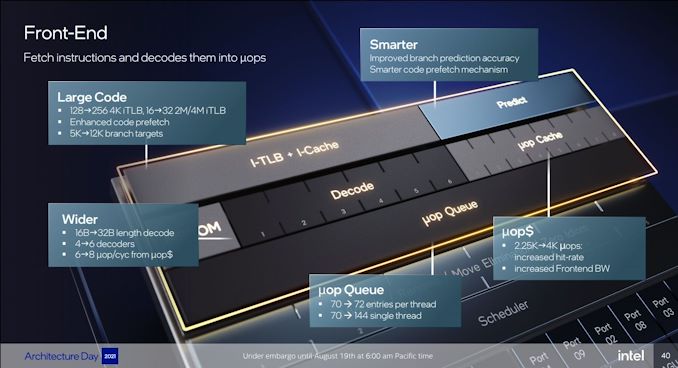
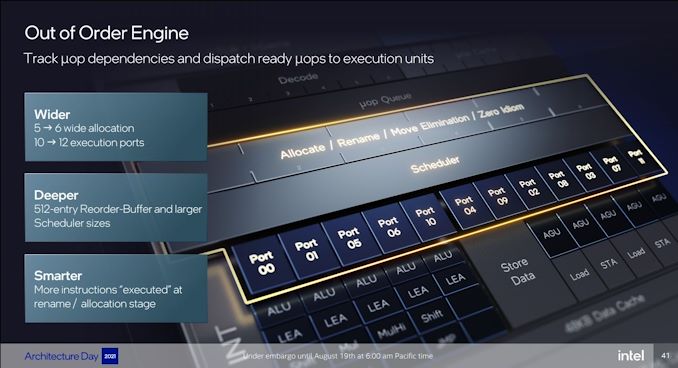
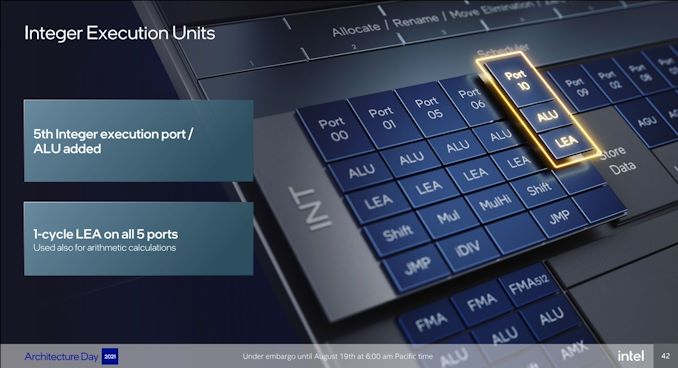

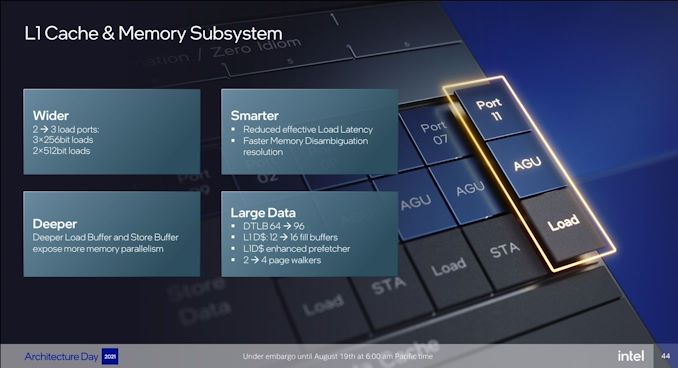
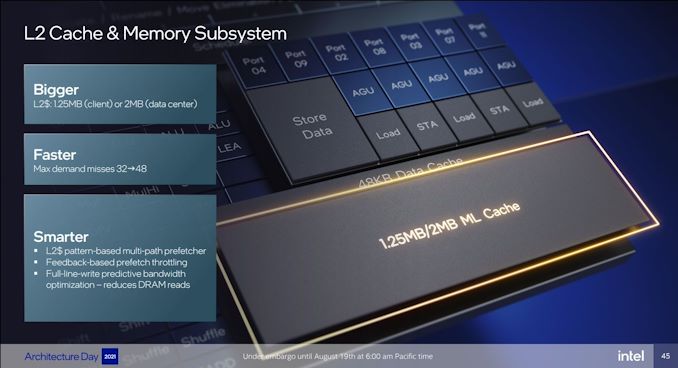
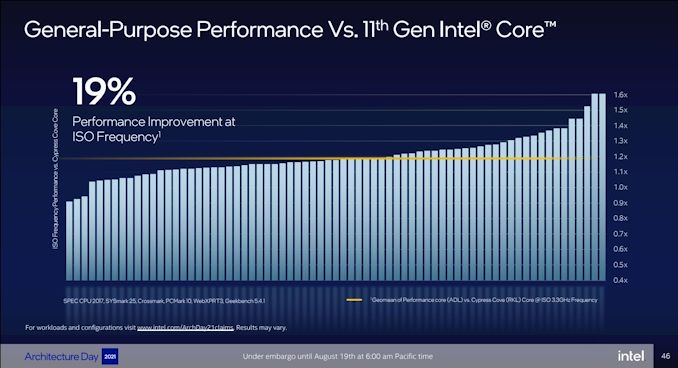








223 Comments
View All Comments
TristanSDX - Thursday, August 19, 2021 - link
"decreasing the manufacturing cost for Alder Lake, by using all the defect chips and reserving the good ones for Sapphire Rapids."Alder Lake and Shapire Rapids are two totally diffrerent chips
mode_13h - Thursday, August 19, 2021 - link
> Designed as its third generation of vector instructionsDepends on how you're counting. First is definitely MMX. That was extended in a few subsequent CPUs, but they didn't call those extensions MMX2 or anything. MMX was strictly integer, however, and total vector width was 64 bits. MMX had the annoying feature of reusing the FPU registers, which complicated mixing it with x87 code and basically requiring a state reset, when going from MMX -> x87 code.
Then, SSE came along and added single-precision floating-point. It also added a distinct set of vector registers, which were 128 bits. Finally, it included scalar single-precision arithmetic operations, beginning the era of x87's obsolescence.
SSE2 followed with double-precision and integer operations, making MMX obsolete and further replacing x87 functionality.
SSE3, the wondefully-named SSSE3, and a couple rounds of SSE4 came along, but all were basically just rounds of various additions to flesh out what SSE/SSE2 introduced.
Then, AVX was introduced as something of a replacement for SSE. AVX registers are 256 bits. Like SSE, AVX was initially just including single-precision floating-point support. And like SSE2, AVX2 added double-precision and integer operations.
Then, Xeon Phi (2nd gen) and Skylake-SP introduced the first variations on AVX-512 support. You can see what a mess AVX-512 is, here:
https://en.wikipedia.org/wiki/AVX-512#CPUs_with_AV...
Anyway, AVX-512 should be considered Intel's FOURTH family of vector computing instructions, in x86. I think the first time they dabbled with vector instructions was in the venerable i860 - a very cool, but also fairly problematic step in the history of computing.
> (AVX is 128-bit, AVX2 is 256-bit, AVX512 is 512-bit),
No, not at all. The register width for AVX and AVX2 is 256 bits, as I explained above.
However, even that is a slight simplification. AVX introduced some refinements in vector programming, such as a more compiler-friendly 3-operand format. Therefore, it was meant to subsume SSE usage, and included support for 128-bit operations. Similarly, AVX-512 introduced further refinements and the capability to use it on 128-bit and 256-bit operands.
For more, see: https://en.wikipedia.org/wiki/AVX-512#Encoding_and...
mode_13h - Thursday, August 19, 2021 - link
One more correction:> Some workloads can be vectorised – multiple bits of consecutive data all require
> the same operation, so you can pack them into a single register and perform it
> all at once with a single instruction.
Intel's vector instruction extensions aren't strictly SIMD. They include horizontal operations that you don't see in classical SIMD processors or most GPUs.
mode_13h - Thursday, August 19, 2021 - link
> One could argue that if the AVX-512 unit was removed from the desktop> cores that they would be a lot smaller
That's what I thought, but the area overhead it added to a Skylake-SP core was estimated at a mere 11%.
https://www.realworldtech.com/forum/?threadid=1932...
Of course, we can't yet know how much of Golden Cove it occupies, but still probably somewhere in that ballpark.
mode_13h - Thursday, August 19, 2021 - link
> Intel isn’t even supporting AVX-512 with a dual-issuePerhaps because AVX-512 doubled the number and size of vector registers. So, just the vector register file alone would grow 4x in size.
Schmide - Thursday, August 19, 2021 - link
64bit packed doubles are in avx as are some 64bit ints. AVX2 filled in a lot of gaps such as full vector operands and reorders. So as much as AVX2 finished off the 32 and 64bit ints (epi) functions. There was already a fair amount in avx.Schmide - Thursday, August 19, 2021 - link
not to be misleading. There were really no usable int functions in avx other than load and store.maroon1 - Thursday, August 19, 2021 - link
Gracemont beats skylake ???? Really ? I'm reading the article correctlySo these small cores are actually very powerful !!
vegemeister - Thursday, August 19, 2021 - link
The hypothetical 8% increase in peak performance seems like wishful thinking to me. The chart looks like "graphic design" marketing wank, not plotted data. I would only go by the printed numbers. That is, at an operating point that matches Skylake peak performance, Gracemont cores use less than 60% of Skylake's power, and if you ran Skylake at that same power, it would have less than 60% of Gracemont's performance.mode_13h - Thursday, August 19, 2021 - link
> I would only go by the printed numbers.Okay, so are those numbers you used hypothetical, or where did you see 60%?
Also, there's no fundamental reason why the ISO-power and ISO-performance deltas should match.